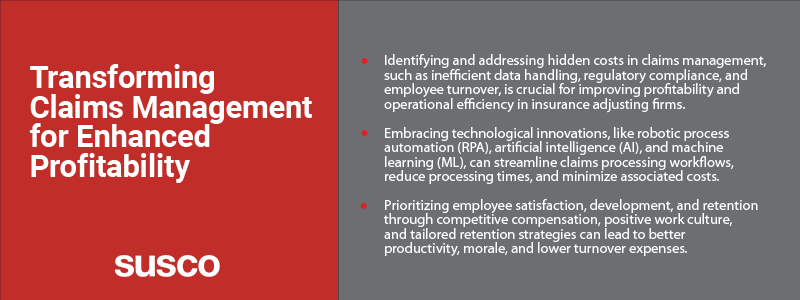
Beneath the seemingly calm surface of insurance operations lie hidden expenses akin to the submerged bulk of an iceberg. These concealed costs, often overlooked or underestimated, significantly impact the profitability and efficiency of insurance adjusting firms.
Recognizing and addressing these hidden expenditures is pivotal in navigating the complexities of modern business and achieving sustained financial success.
Inefficiencies in Data Handling and Technology Integration
Outdated or inadequately integrated technology is not just a barrier but a significant roadblock to operational efficiency.
Legacy systems and disjointed software platforms severely impede the seamless data flow, resulting in prolonged processing times and heightened error rates.
These inefficiencies force employees to spend more time manually handling tasks, increasing the likelihood of errors and costly corrections, which can harm customer satisfaction.
When different systems can’t easily share information, analyzing all the claims data together becomes challenging, slowing down decision-making processes.
Compliance and Regulatory Overhead
The insurance industry faces a constantly changing and complex regulatory environment. Keeping up with new regulations requires time, money, and staff.
Failure to comply with regulations, whether by mistake or on purpose, can lead to large fines and increased regulatory monitoring. This puts further strain on finances and damages stakeholders’ trust.
Regulatory audits also add to the overall cost of compliance in terms of time and money.
Managing these risks and protecting their financial health requires insurance adjusting companies to implement strong compliance management systems, including advanced technology and active monitoring of regulatory changes.
Training and Employee Turnover
High employee turnover is a big problem for insurance companies. It disrupts work and causes the loss of valuable knowledge and skills, especially in areas like claims adjustment and analysis.
Recruiting and training new employees is expensive. It includes costs like recruitment fees, training expenses, and lost productivity during the transition. These costs add up fast and strain budgets. But money isn’t the only issue. Turnover also hurts employee morale and engagement.
When workers see colleagues leaving, it creates uncertainty and instability, lowering productivity and effectiveness and worsening the problem.
Insurance firms must focus on keeping employees happy to fight these adverse effects. This means providing competitive pay and benefits, a positive work culture, and chances for growth and learning. Firms should also use retention strategies that fit their unique workforce.
Flexible work options, mentorship programs, and rewarding top performers are all ways to keep employees engaged and connected to the organization. A proactive approach can lower turnover risks and create a more stable and productive workforce.
Bottom line: insurance firms must attract, develop, and keep the best talent to succeed.
Prioritizing employee satisfaction and lowering turnover may have short-term costs, but the long-term benefits are worth it. These efforts lead to better productivity, morale, and lower turnover expenses.
The Cost of Delayed Claims Processing
Delays in claims processing are a major roadblock for insurance adjusting firms, causing significant problems in the operational workflow and leading to far-reaching financial implications.
Prolonged processing times result in policyholders waiting longer for their claims to be resolved. This situation frustrates customers and requires the firm to allocate more resources to manage and administer the claims.
As a result, additional expenses accumulate, including higher compensation payments to claimants and increased administrative overhead costs. These extra costs eventually strain the company’s financial reserves and compromise its overall profitability.
To address these challenges, insurance firms must embrace technological innovations that streamline their claims processing workflows. Robotic process automation (RPA) can automate many repetitive and time-consuming tasks involved in claims processing, freeing human workers to focus on more complex and value-added activities.
Artificial intelligence (AI) and machine learning (ML) can be leveraged to enhance decision-making capabilities and identify patterns and trends in claims data that might go unnoticed. Implementing these technologies allows insurance adjusting firms to reduce claims processing times and minimize the associated costs.
Faster processing means that policyholders receive their payments sooner, improving customer satisfaction and loyalty. It also enables the firm to handle a higher volume of claims without hiring additional staff or investing in more resources.
Implementing these technologies comes with its own set of challenges. Insurance firms need to carefully consider which solutions best fit their specific needs and workflows and invest in the necessary training and support to ensure that their staff can use the new tools effectively.
They must also be mindful of these technologies’ potential risks and limitations, such as the potential for bias in AI-powered decision-making or the need for robust data security measures.
The journey towards sustainable profitability for insurance adjusting firms necessitates a proactive approach to identifying and mitigating hidden costs across all facets of claims management.
By addressing inefficiencies in data handling and technology integration, navigating regulatory complexities with finesse, prioritizing employee retention and development, and embracing innovative solutions to expedite claims processing, firms can unlock substantial savings and enhance their competitive positioning in the market.
Are you ready to wipe out those hidden costs?
Susco remains committed to supporting IT leaders and decision-makers in their quest for operational excellence and financial resilience. We offer tailored solutions to optimize claims management processes and drive tangible business outcomes. Susco experts leave no stone unturned in the quest for customer satisfaction and efficiency. Contact us today to learn more.